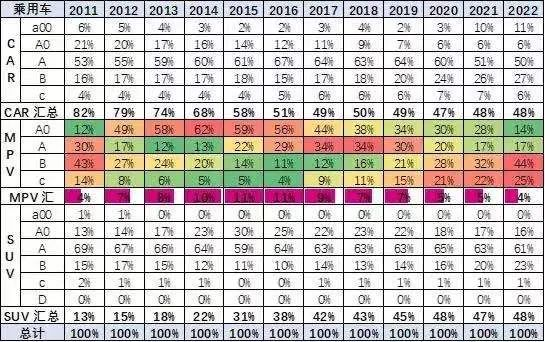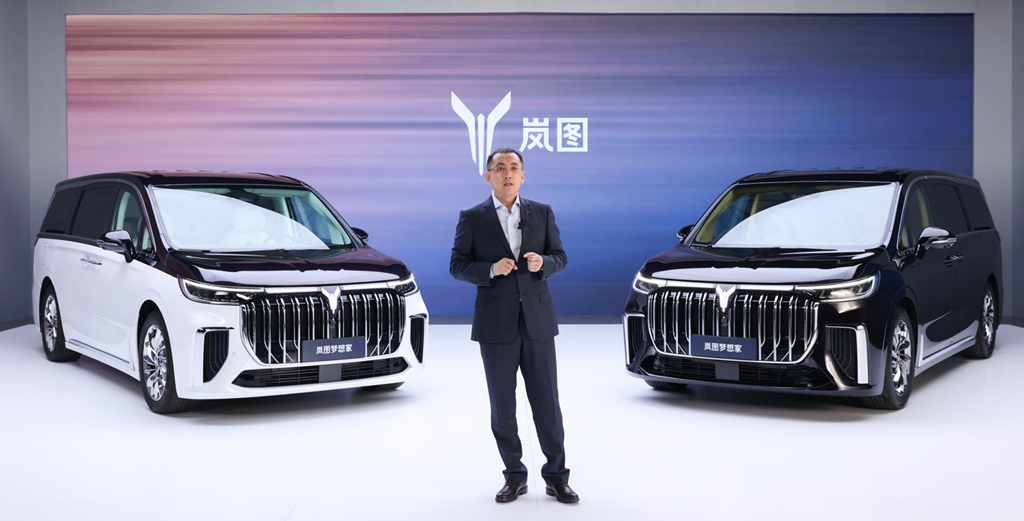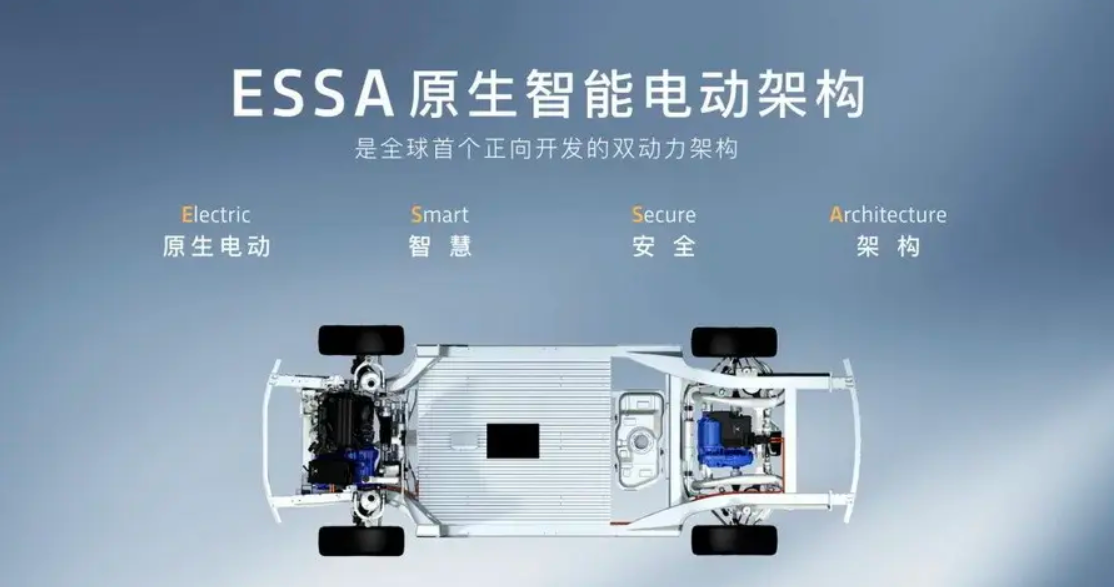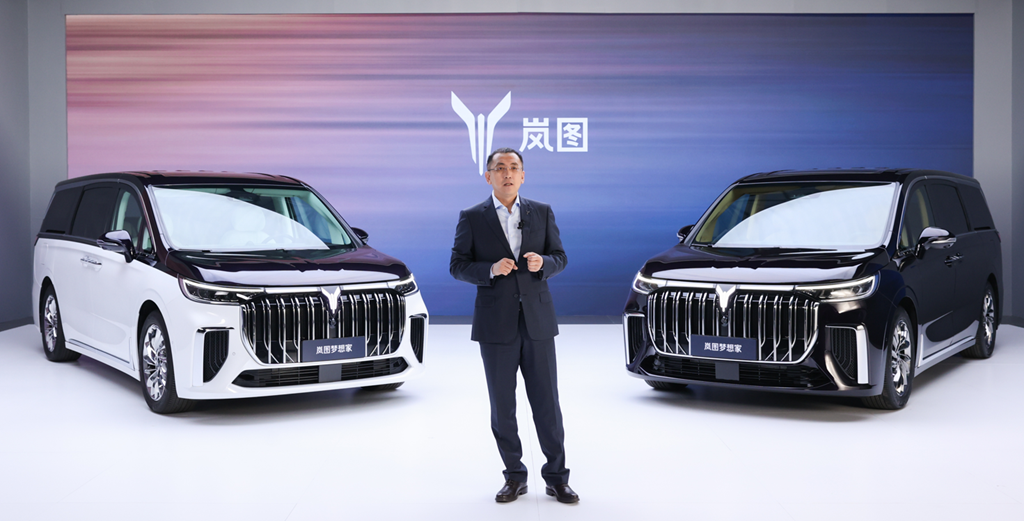Autor:Feng Jingang
On May 7th, the new force LanTu’s second car Dreamer was officially launched. This is a high-end MPV. Unlike the MPVs on the market, Dreamer is an intelligent electric car and the first high-end intelligent electric MPV in the industry.
The birth of LanTu Dreamer means that the 39-year history of MPVs has ushered in a new species. Intelligent electric cars are marching into various segmented markets. With the arrival of Dreamer, the clarion call for intelligent electric cars to attack the MPV market has sounded.
To make an MPV, you must first understand what an MPV is. If you want to make a good MPV, you must find the corresponding scenario for the MPV.
Now, government and family are the two major application scenarios for MPVs. However, the earliest birthplace of MPVs was families, and then it was extended to governments.
In 1973, the first oil crisis broke out. Six years later, the second oil crisis broke out. The consecutive outbreaks of two oil crises not only caused global turbulence but also had a significant and far-reaching impact on the global automobile industry.
In the United States, the two oil crises changed the automotive consumption concept of many American families. They began to pursue Japanese cars known for their fuel efficiency, which allowed Japanese cars to rise, but also almost wiped out the “gas guzzling” American cars.
However, faced with the strong offensive of Japanese cars, American cars did not surrender easily.
At that time, in order to regain the trust of American families, one of the three major American automakers, Chrysler, was thinking of a solution. One of them was to develop a small box-type passenger van suitable for American family use, which was different from the full-size station wagon.
Mini Passenger Van is also the definition of MPV for American cars.
In 1977, a plan called “T115” was established within Chrysler. On November 2, 1983, two revolutionary new cars, the Chrysler Plymouth Voyager and the Dodge Caravan, were launched at an automobile assembly plant in Windsor, the southernmost city in Canada.
These two cars are hailed as the pioneers of modern MPVs. Among them, Chrysler Plymouth Voyager is the predecessor of the well-known Grand Caravan.
From 1983 to the present, the history of MPVs has been 39 years.
And Lee Iacocca, who led Chrysler to launch this epoch-making model, is one of the iconic figures in the American automotive industry. He has various nicknames, including the “father of Mustang” and the “father of Viper,” and is also regarded as a dreamer of the Detroit industrial American dream.The reason why Lee Iacocca came up with such an idea is that in the early 1970s, the United States saw the “baby boom” after World War II, and he believed that American families needed a high fuel-efficient, spacious and comfortable, moderately priced “Minivan”.
Here is an anecdote: when Lee Iacocca proposed the MPV idea, he was still working for Ford. However, Ford II did not adopt his idea and even felt that he was always thinking about some ridiculous things.
As it turned out, Lee Iacocca was right, and his legendary story continues.
After being introduced to the market, the two MPV models were well received by users. In the first year of sales alone, 210,000 vehicles were sold, far exceeding the previous sales target of 50,000, and also the sales profit line of 155,000 vehicles.
Yes, Chrysler’s insight into market demand has paid off.
In the following 20 years, Chrysler accumulated sales of over 10 million MPVs in more than 70 countries and regions worldwide, becoming a well-deserved MPV expert.
After Chrysler introduced the MPV, the MPV craze swept the globe, and MPV became an important automotive subdivision market.
It is worth mentioning that in 1984, Renault launched a new model called Espace. Europeans called Espace a Multi-Purpose Vehicle, also known as MPV.
Multi-Purpose Vehicle, is now the more recognized definition of MPV.
The reason why MPV was widely recognized by the market after its introduction was due to its practical and powerful product strength.
Taking the US market as an example, MPV changed the truck chassis of full-size traveling cars, adopting a sedan chassis, and moved the front cabin forward. These two technological modifications were crucial to the rise of the MPV.
After these adjustments, MPV further increased its advantages in large space (such as flat chassis, more flexible seat arrangement) and also combined with the comfort and handling of a sedan. In addition, the bullet-like design competitive fuel consumption compared to full-size station wagons.
Subsequently, with more luxury attributes added due to its high scalability, such as larger space, safety, and more comfortable features, MPV shifted from the family to the business market, becoming both Ikea and commercial.
Of course, many MPV models still adhere to the family user market.
After conquering the family MPV market in 1990, Chrysler continued to enter the luxury MPV market with Town&City, which has long dominated the U.S. market for upscale MPVs above $30,000, with a market share of 68%.From Voyager to Town&City and other MPVs, Chrysler’s success reflects their powerful market insight and product definition gained from being driven to desperation.
Chrysler invented the MPV, and the MPV saved Chrysler.
The significance of this business story lies in Chrysler’s ability to read and fulfill changing user demands in the MPV market, becoming an important reference for later entrants pushing MPV models.
Yes, the development of MPVs has little to do with China’s auto industry, even the MPV name itself was not established until the introduction of Buick GL8 by Shanghai GM in 1999.
Before that, MPVs were commonly referred to as “bullet heads” in China according to their appearance, such as Chevrolet Lumina and Toyota PREVIA.
China’s MPV culture can be broadly categorized into three types:
First, the high-end private car culture led by Toyota Alphard, commonly known as “nanny cars”.
The origin of this definition can be traced back to Hong Kong, Hong Kong movies, and Hong Kong stars.
Because of its high population density and high cost of car ownership, MPVs that can both transport people and cargo have become the preferred choice for families in Hong Kong, and therefore the presence of MPVs is common in Hong Kong movies.
Many Hong Kong stars are also particularly fond of MPVs, leading to the establishment and popularity of the high-end nanny car culture, especially Toyota Alphard, which is like a magical car in the nanny car world.
In the 1980s and 1990s, Hong Kong movies enjoyed a golden age, and through the influence of movies and the power of the stars, MPVs became the symbol of high-end private cars.
Of course, among these MPVs, more are from Japanese brands. Even today, Japanese MPVs leave a strong impression on the Chinese market as private cars.
In 1994, the Honda Odyssey was imported to China, with Honda positioning it as a family MPV, a positioning that has been maintained to this day.
Such positioning has pros and cons – on the one hand, both Odyssey and later Entourage became benchmarks of high-end family MPVs, while on the other hand, it limited their development in the commercial vehicle market.
For many years, Honda’s “MPV twin heroes” have been unable to compete with Buick GL8 due to differences in positioning.
Second, the high-end commercial car culture led by Buick GL8.1992, General Motors brought the Chevrolet Lumina APV into China through the Far East-China Trading Company in Hong Kong. By the end of 1993, nearly 10,000 Lumina APVs had been imported into China with duty-free quotas, making it one of the best-selling MPV models at the time.
In 1999, Shanghai GM introduced the Chevrolet Venture as a replacement for the Lumina APV, and placed it under the Buick brand, naming it the GL8, thus marking the beginning of a legendary icon.
Over the course of 23 years, the GL8 has developed into four generations, with the fifth generation ready to make its debut. As of December 14th, 2021, GL8 has sold over 1.5 million units, truly deserving the title of “King of high-end MPVs”.
Moreover, the glory of the GL8 has not stopped.
In 2021, the GL8 family has accumulated sales of more than 170,000 units, an increase of 8.4% year-on-year, with an average monthly sales volume of more than 14,000 units, continuing to stand out as a unique model in the high-end MPV market.
Among the sales composition, the mid- to high-end Aviar and ES Landzun sales account for nearly 60%. In the high-end MPV market in China with prices above 300,000 RMB, the GL8 accounts for approximately 43%, ranking first in the market segment. Among all joint venture brand MPVs, the GL8 accounts for more than half, reaching 53%.
The reason why the GL8 remains popular after four generations is that it closely follows the pulse of the commercial vehicle market. As the saying goes, the Buick GL8 is the Audi A6L of the MPV market.
However, when Shanghai GM initially introduced the GL8, it was positioned for the family car market. After receiving a lukewarm response, it was repackaged as the “Land-based Executive Chamber,” aimed at the corporate market.
Some may wonder why the Buick GL8 can beat the more powerful Mercedes-Benz MPV. One of the key technical points is that the Mercedes-Benz MPV comes from the Mercedes-Benz commercial vehicle platform, rather than a passenger car platform, with relatively poor comfort.
This shows that the high-end MPV market is not solely dependent on brand strength, but rather the strength of the product.
In the official introduction of the GL8, there is a sentence, “Perfection lies in the details, achieving the ultimate courtesy,” which may be the deep reason why the GL8 has always been proud of its peers.
Thirdly, the culture of low-end public-private-use vehicles initiated by Wuling Hongguang.
The great success of the GL8 allowed SAIC to develop a deeper understanding of the MPV market. Therefore, after the GL8, SAIC planned another heavy MPV; the Wuling Hongguang.On September 6, 2010, Shanghai GM Wuling officially released its first MPV, Wuling Hongguang. Wuling truly deserves to be called the creator of miracle cars. Within half a year of release, Wuling Hongguang monthly sales exceeded 20 thousand vehicles, and later the highest monthly sales exceeded 60 thousand vehicles, setting a new record in the history of independent car models.
The secret of Wuling Hongguang’s success lies in its being the creator of a Chinese unique MPV that is both commercial and suitable for family purposes.
In fact, at the beginning of its release, there were still doubts in the industry about Wuling Hongguang’s MPV identity, thinking that it was too cheap, and that its pricing was inconsistent with the high cost of MPVs in people’s impressions.
Regardless of the price, whether it is structural design or multi-functional attributes, Wuling Hongguang meets the definition of MPV, and it has caught the strong demand of China’s huge ordinary households for MPVs. It is a national MPV.
Currently, China has become the largest market for MPVs in the world. After years of development, various sub-markets have also become more and more mature, mainly divided into the above three categories. To succeed, new entrants must choose one and fight.
In recent years, except for GAC passenger cars’ decent achievements through M8+M6, no other attempts have made breakthroughs.
So, where is the opportunity for MPVs?
In the past decade, both the MPV and SUV sub-markets have made leaps and bounds, but they have shown different development curves. MPVs are on a trajectory from low to high, and then decline, while SUVs continue to rise and stabilize.
The reason why the potential of SUVs is greater than that of MPVs is that their product boundaries are more blurred, and they are suitable for a wider range of people. Therefore, SUVs have become the mainstream market, while MPVs are still a sub-market.
In the evolution of the domestic MPV market, various sub-markets have performed differently. Among them, the A-level MPV market is gradually declining, while B and C-level MPVs have achieved new highs, with a cumulative market share of 69% in 22 years.
It is evident that high-end MPVs are still in strong demand.
Therefore, we can see that last year, Kia Jiahua, Hyundai Kusso and Toyota Seina and other new MPVs were successively launched, and they have received good responses.
In addition to traditional MPVs, the new energy MPV market is also in the works.
In 2021, the cumulative wholesale sales of MPVs reached 1,055,234 vehicles, a year-on-year increase of 0.1%. Among them, the sales of fuel-powered MPVs were 925,780 vehicles, a year-on-year decrease of 2.8%, while the sales of new energy MPVs were 35,027 vehicles, a year-on-year increase of 137.5%.


Short-term-wise, the fuel MPV market will be filled with internal competition and battle, while the new energy MPV opens up a new track and remains a virgin land, with various niche markets waiting for people to explore and define.
In the long run, new energy MPVs will eventually replace fuel MPVs.
Why will new energy MPVs eventually replace fuel MPVs? At its core, the core product power of fuel MPVs is being covered by new energy MPVs.
Space. New energy MPVs, especially electric MPVs, come from pure electric architecture, which means that they have more expandability in terms of space.
Safety. Both the support of the new architecture and the smart configuration have further improved the safety of new energy MPVs.
Although GL8 has dominated the domestic MPV market for many years, its safety issues have been criticized by many people.
GL8 comes from Chevrolet Venture and is a product of the GM U platform, which was born in 1990. Its models performed poorly in various U.S. crash tests, especially the A-pillar breaking, which directly led to the market failure due to poor safety. In 2006, GM completely stopped U platform production.
The question is thought-provoking, why has GL8, with its poor safety genes, dominated the Chinese MPV market for so many years?
Clearly, the Chinese high-end MPV market urgently needs a “dreamer” to end the dominance of GL8, which was born 32 years ago.
As the saying goes, once you drive an electric vehicle, you can no longer go back to a fuel vehicle, including MPVs, of course.
Save money. Compared with fuel MPVs, new energy MPVs undoubtedly save more money, especially for those users with home charging.
In addition, in cities with license plate restrictions and purchase restrictions such as Beijing, Shanghai, and Guangzhou, new energy MPVs can also save license plate costs and unlock more road rights. These cities are also the current battlegrounds for new energy MPVs.
However, pure electric MPVs also have obvious disadvantages, such as insufficient endurance and inconvenient battery charging. Of course, the specifics depend on different users’ usage environments.
Therefore, the dual-power layout of pure electric + plug-in hybrid is currently a more practical solution for new energy MPVs.
For the insight of the new energy MPV market, LanTu, the pioneer, has a clearer understanding.
At last year’s Guangzhou Auto Show, when talking about the launch of the “Dreamer” era, LanTu CEO&CTO Lu Fang said that there is still no MPV that truly takes care of the needs of both family and business travel in the market, no MPV that truly meets the needs of high-end electric MPVs that are in line with current development trends, and no MPV that truly meets the needs of family economic travel while allowing people to enjoy high-end quality.
As the first high-end intelligent electric MPV on the market, the Voyah Dreamer is a new species born to be different, pioneering the new category of electric MPVs, and setting a new benchmark for luxury electric MPVs, leading the MPV into a new era of electrification and intelligence.
In addition to insight and market definition, Lu Fang also did an in-depth analysis of the supply-demand logic of the new energy MPV market.
Lu Fang believes that in the traditional automobile market, no matter what type of vehicle, it is generally divided into 2B and 2C markets. However, the new energy market is in its early stages, and consumers tend to follow the core logic of choosing according to their needs.
Therefore, in the consumer user portrait of the Dreamer, Voyah did not particularly emphasize targeting the family market, travel market, or government market, but could be customized according to user needs.
What kind of self-cultivation should a high-end new energy MPV have? As the first product in the industry, the Voyah Dreamer gives us an answer.
On May 7th, the Voyah Dreamer was officially released. Lu Fang, CEO and CTO of Voyah Motors, said: The Dreamer is a new species born to be different, pioneering the new category of electric MPVs, and setting a new benchmark for luxury electric MPVs, leading the MPV into a new era of electrification and intelligence.
In terms of technology, the Dreamer has 17 MPV-first technologies and 21 leading technologies in the same class, integrating electric, intelligence, performance, comfort, and safety.
Voyah emphasizes that the Dreamer is the most low-carbon MPV for global travel, and also the most comfortable MPV in the world.
Specifically, unlike traditional fuel MPVs, the Dreamer was born on the ESSA native high-end intelligent electric architecture, which has many advantages such as inherent intelligence, extreme safety, easy control, all-round comfort, excellent performance, and excellent space.

In terms of intelligence, the Dreamer is the first MPV equipped with the Qualcomm 8155 chipset, with L2+ intelligent driving assistance, remote parking function, and a three-screen cockpit, and also supports OTA.
In terms of safety, the Dreamer is developed using a super-five-star safety standard, with a globally pioneering 2000Mpa integral hot-forming laser-welded door ring, 2000Mpa aluminum silicon-coated door anti-collision beam, and the whole vehicle is made of more than 70% high-strength steel, achieving a highly strong cage-type cockpit frame.On battery safety, considering that the MPV has a lower ground clearance, the Dreamer adopts a full-scene battery safety protection system and creates a 1500MPa hot-formed high-strength steel battery pack bottom guard plate. In addition, it also applies cloud BMS technology, featuring PDD millisecond-level thermal runaway active power cut-off for further safety assurance.
Moreover, the Dreamer is also equipped with active safety technologies such as fatigue driving monitoring and night vision system, further enhancing safety.
On the suspension side, the Dreamer is equipped with an aluminum alloy front double-wishbone + rear five-link suspension form, with solid tuning skills, achieving an effective balance between vehicle passing, driving stability, ride comfort, and ease of getting on and off compared to traditional fuel-powered MPVs.
It is worth mentioning that the Dreamer is the world’s first MPV equipped with air suspension + CDC, with magic carpet function, which can achieve the driving and riding sensation of an executive sedan by intelligently adjusting the shock absorber damping.
In terms of power, the Voyah Automobile is powered by “Lanhai Power”, which provides a hybrid + pure electric new energy dual-power assembly that can run on petrol or electricity. It has four major advantages: super power, high efficiency and energy saving, convenient energy supplementation, and extreme safety, all centered around user demand.
The Dreamer 0-carbon version is equipped with front and rear dual motors with a maximum power of 160kW/160kW, peak torque of 620N·m, and can accelerate to 100km/h in 5.8 seconds. The Dreamer low-carbon version is equipped with front and rear dual motors with a maximum power of 130kW/160kW, peak torque of 610N·m, and can accelerate to 100km/h in 6.6 seconds.
Among them, the Lanhai hybrid intelligent multi-mode drive assembly uses Dongfeng’s self-developed 1.5T GDI “Chinese Heart” top 10 engines, with a thermal efficiency of 41.07% and an engine direct drive mode.
Regarding fuel consumption, the Dreamer low-carbon version achieved a comprehensive fuel consumption of 7.4L/100km under WLTC conditions. For comparison, GL8’s data is 7.94 and 8.08L/100km.
In terms of comfort, the Dreamer has more than 80 noise reduction designs throughout the vehicle, making the interior noise lower than that of ultra-luxury executive sedans at speeds of 60km/h, 80km/h, and 120km/h. Coupled with the quiet driving characteristics of the electric drive, it achieves the sound insulation effect of a deep-sea level.
Regarding space, the Dreamer provides a total of 41 storage spaces throughout the vehicle. With seven people onboard, four 24-inch suitcases can be easily loaded without folding down the third row. In addition, the 0-carbon version model offers a 40L front trunk.
What is the Dreamer? Lufang summarizes: “It is a movable living room, a movable warm home. It can run on petrol or electricity, suitable for both home and business, both urban and distant, and is the mobile third space that everyone wants to own.”As a high-end MPV, Dreamer is impeccable.
The LanTu Dreamer is divided into the “Dream” series, “Think” series, and “Home” series, with the “Home” series priced at 369,900 yuan, the “Think” series priced at 389,900 yuan, the “Dream” series priced at 439,900 yuan, and the private customized version starting at 639,900 yuan.
According to current data, since pre-sales began on April 7th, LanTu Dreamer has received over 4000 orders and is expected to start delivery in the third quarter of this year.
Electric Power Talks
As an important market segment in the automotive industry, MPVs have both commercial and family attributes, and especially commercial attributes that are essential and irreplaceable.
This also means that if you want to enter the MPV market, the commercial market is an important consideration.
Today, with the advent of the intelligent electric era, MPVs have entered an era that urgently needs definition. This is a once-in-a-lifetime opportunity for all brands.
As a new force representative, LanTu takes the lead with powerful products and launches Dreamer, completing a strategic overtaking and demonstrating the leading strategic planning of LanTu and the profound internal strength of product completion.
Of course, in order to ultimately define the high-end smart electric MPV, LanTu still needs more efforts. Fortunately, it has already set off.
This article is a translation by ChatGPT of a Chinese report from 42HOW. If you have any questions about it, please email bd@42how.com.
